Diorama Dedicated to the Bulgarian Legendary Pilot Dimitar Spisarevski, Bozhurishte Airfield, December 1943
By Yordan Kolchev
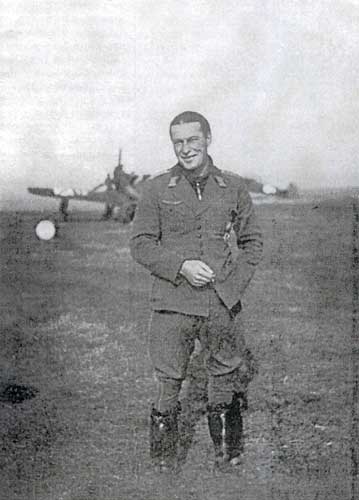
This is how I decided to title my article dear readers and modeling colleagues. I would like to acquaint you in brief with the story of this great Bulgarian hero whom I have dedicated my work - this diorama on scale 1/32.
A lot has been written about Dimitar Spisarevski (http://en.wikipedia.org/wiki/Dimitar_Spisarevski, http://www.bnr.bg/RadioBulgaria/Emission_English/Theme_Profiles/Material/spisarevski.htm), and I present him as a great Bulgarian patriot who gave his young life, his faith in the future of Bulgaria and his will to resist to the powerful enemy.
The following words depict him best - the hero Dimitar Spisarevski, with his extraordinary feat of arms and conscious self-sacrifice, deviated the British bombers from their purpose to bomb the civil innocent people in the capital of Bulgaria Sofia.
Dimitar Svetozarov Spisarevski was born on 19th June 1916 in the town of Dobrich and was an offspring of the old Revival family. By November 1919 the family lived in Dobrich, called Bazardjic by the new Romanian authorities, conquered South Dobrudja after our defeat in the World War I and the signing of Treaty of Neuilly*. His father, the reservist Svetozar Spisarevski, who was truly Bulgarian, did not recognize the regulations of the repressive Romanian authority and declared his nationality, which led to their internment from Dobrich.
In 1931 his father started work in Sofia where Dimitar was a student in Second Boys' High School. Here is a fact which is not very popularized. In November 1943 the American Air force bombed Sofia three times, and on 20th December aimed at the Bulgarian capital for the fourth time. This was the date when Spisarevski committed his heroic deed and voluntarily crashed into the leading commander's bomber, thus making his name immortal.
Spisarevski's sacrifice remained oblivious for decades, veiled in mystery and distrust, discrediting rumours and fables went about and not without a reason! They said that at a demonstration against the Treaty of Neuilly, which trimmed and mistreated Bulgaria, Dimitar physically striked his classmate, the international socialist Stoyan Gyurov (later a member of the Central Committee of the Bulgarian Communist Party and the ambassador in Moscow), who participated in a counter-demonstration (i.e. supporting the anti-Bulgarian Treaty of Neuilly!).
Yet another fact, from our socialist period, after a short column about Spisarevski in the Pogled newspaper, our ambassador in Moscow introduced this 'international issue' to Todor Zhivkov, the Prime Minister of socialist Bulgaria during the nearly 50-year communist dictatorship. Spaich's (Spisarevski's) physical strikes must have been rather tough and echoed for decades.
On the subject of the fighter flying officer Dimitar Spisarevski, we must never forget that he was an instructor at the Fighters' School of the Military Air Forces of the Bulgarian Kingdom for some time. It is clear that certain qualities are needed for an instructor at a fighters' school - excellent flying skills, to serve as an example for the future fighters, pedagogical abilities, and profound understanding of the pilot's soul. It seems Spisarevski had most of them.
This is what Todor Valkov said in his article in Krile Magazine:
'I'll say a few words about flying officer Poruchk Dimitar Spisarevski. He was sent together with flying officer Poruchk Banov to Germany, in the area of the English Channel to master aerial warfare tactics of the 8th American Air Force without participating in the fights. They join squadron JG2 Richthoffen in the wing of major Egon Mayer who develops, together with Georg Eder from the same squadron, tactics for an attack of the four-engine bombers, frontally. It was a very efficient method but required a great deal of skill, bravery and nerve because the speeds of the flying planes were added and made 850km/h. In our Bulgarian fighting air force history, as far as we know, only flying officer Stoyan Stoyanov used it once on 1st August 1943. When he returned from Germany, Spisarevski reported to the whole flying staff at Marno Pole Airport. I was there too. Then we learned in details about the way the American bombers acted. Spisarevski also explained that some of the German fighters are armed with rockets 'air - air', which was something entirely new in the field of the plane armaments at that time.'
It's a curious fact that the senior German instructor at the Marno Pole Airport major Kulle said that Spisarevski would die in the first air battle! I consider he was a good psychologist and judged Spisarevski's character and behavior: reckless, brave, determined, stubborn in his attempt to achieve his aim and ardent patriot. All these led him to the decision to crash into the enemy bomber on 20th December in order to prevent the bombing of Sofia.
Just before the occupation of Bulgaria by the Red Soviet army on 9th September 1944 Kulle had to leave Bulgaria and on his farewell with our pilots said:
'I have to go back to my country now. But if we ever have to confront each other, do your duty as I shall do mine!'
In my opinion, said Todor Valkov, he succeeded to express in short the grievous and heroic philosophy of war: the mother country comes first, and all the rest remains behind, even friendship!
Major Helmut Kulle died as the commander of JG6 3rd group on 1st January 1945 during operation Unternehmen Bodenplatte (Operation Ground Plate).
Spisarevski not only spoke German very well but he also learned Russian at Sofia High School as well as the classical pre-revolutionary Russian literature and he loved singing Russian classical romances. His language skills and general knowledge undoubtedly made him a broad-minded person, unprejudiced to other people and cultures, but politically mature to see clearly that internationalism and communism were harmful for small Bulgaria, often surrounded by hostile neighbours.
Ivan Spisarevski - the hero's brother - said: Dimitar was a nationalist and hated the "Remsists" *Young Communist League and the communists.
Did Dimitar prepare for his immortal crash? There is some evidence about it, and I would like to tell some of the facts in brief.
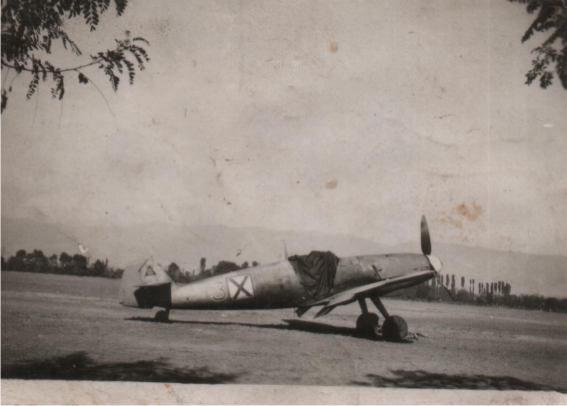
The mechanic of his plane sergeant major (feldfebel-chkolnik) Ivan Petrov said, 'I learned from sergeant major feldfebel-chkolni cadet Kiril Manov that they asked Spisarevski the previous evening what he would do if he ran out of ammunitions during an air battle. He answered, 'I would get on it, but I would not let them harass our country!'
A few days later Spisarevski did not talk to anybody but he walked along the ground with his hand on his waist. There was a sergeant major cadet Yanko Dishliev from Chirpan, with who they often told jokes. Let me convey their conversation in short Spisarevski told us., 'You look at the petrol metre, brother (thus he addressed his friends), you don't have any fuel. You don't have any ammunition. At this moment you feel that you are bleeding, you are hit. Your fingers are going dead, stiff with cold ... what are you going to do?'
As we did not know what to say he waved his hand from top to bottom and said: 'Shame on you! And you consider yourselves Bulgarians! Yanko, you will crash and take down at least one bomber, but you will not let him bomb this sacred land!' And he showed spreading his arms in a pilot's manner the way it would happen.
On 20th December 1943 about 70 four-engine bombers B-24 'Liberator', guarded by around 50-60 fighters P-38 Lightning headed to Sofia.
Misho Grigorov 'Eagles of Bulgaria', part II Fiery Sky.
20th December. The weather was sunny. The sky - clear and serene. We had a feeling that the enemy would take advantage at any rate of the favourable weather for a new attack of Sofia.
We were right. At about 12:30 a red flare was shot and the sirens started sounding alarmingly. We started the engines. Just before the take off I saw flying officer Spisarevski run to his yellow plane Gustav No2 which was near to the left of mine. In his heavy German boots he jumped into the cockpit, thrilled and eager to commence the battle with the enemy. We took off as the reserve and guard of the wing under the leadership of captain Toplodolski. Because Spisarevski was late he joined us at the left end in the battle line while I was just to the right of my leader flying office Poruchk N. Yordanov.
This is how the aerial battle proceeded in brief.
'We identified the silhouettes of the notorious B-24 Liberator from afar. When we came dangerously close, the wing commander diverted us with a sharp manoeuvre to the right and up to the sun.
Flying officer Yordanov dashed right after him. Because of the steep manoeuvre he had to re-form at the other side of his leader. In order not to crash into him for he sank in the rays of the sun which blinded me, I moved to the left, too.
...I got into the highly extended formation of the fighters P-38 Lightning which followed closely their B-24 Liberator. Yet, there were too many of them... Maybe more than 50-60! I had nothing else to do but pass their information. Somewhere to the left, Spisarevski was flying, too, and for a few seconds, we broke through and cross the battle formation of the American fighters. It was a miraculous escape and we did not crash each other. We got into clear sky and when I turned at 180 degrees, my casual lead by my Messerschmitt was lost to sight. Thus I had to fight dozens of fighters instead of attacking the enemy bombers. As I did not find Spisarevski around me, I began to attack by myself. Because of the incessant movement of the lightnings. I could not single out a target. The same thing happened at the second attack. It seemed that the pilots followed me accurately and they warned one another. Meanwhile I noticed Spisarevski's plane somewhere on the right and below but I did not pay any attention to him. At the third attack I shot and I did not know if I had hit the mark. While I was hesitating there was another one, bolder and more determined than me! Disregarding the fighters Lightning flying his yellow Gustav No 2, flying officer Spisarevski hurried to catch up the bombers. All by himself! Against the numerous armada! The rest of our fighters left behind the last group which Spisarevski had headed to. He started to fire and the light traces of his weapons sank in the trunk of the fired bombers. But none was taken down.
I could not keep an eye on the fire and his manoeuvre because I decided to attack once again the fighters. Unfortunately I failed! Spisarevski attacked another bomber from aside. It was not easy to take down these four-engine heavily armed and armoured bombers.
Here is the story of Stoyan Stoyanov: 'Flying officer Spisarevski was the most inflamed in this battle. He came on violently on the enemy several times but always unsatisfied.
...And he got really close to it. The shells hit it deadly. There, finally a flame came out behind the left wing...'
Mihail Grigorov: '...Impetuous approach! Fire! And-explosion! I saw a fire ball and the burning remains of the fortress. But Spisarevski's Messerschmitt was gone. I could see it no more. I wondered how it had happened.

Grigorov second from the right.
Burning pieces from the broken fortress started falling from 7000 metres height. It had exploded and split into three big parts. As if Spisarevski had wanted this exactly.
In Japan they highly acclaimed Spisarevski's heroism as an expression of the great battle spirit of the Bulgarian fighters. Our military and air force attaché in Tokio captain pilot from the Headquarters Branimir Kirkov was asked by telegraph for details about the biography of captain Spisarevski and description of his crash. There were numerous sympathetic telegrams expressing admiration to the Headquarters of Air Forces from the whole country. The telegrams from liberated Macedonia were especially impressing - they denoted the pride of the pilots' feat and expressed their condolences to the casualties' relatives. Flying officer George Kyumyurdjiev also died in that aerial battle - he broke down a four-engine bomber B-24 Liberator and took down P-38 Lightning. Flying officer Kyumyurdjiev died in the same battle with the fighters P-38, exceeded him in a 1:6 proportion.
What else can be said, except, as the witnesses from those times uttered "that on 20th 1944 flying officer Spisarevski in defence of his native sky proved with his unfading feat that he was a man of both in word and in deed! Let us honour his eternal memory!"

Now, let me say something about this diorama and at the beginning I'd like to mention that the completion of the work you can see, took me more than 5 years and it is not by chance! By way of excuse, I would say that I am very busy with my job as a dental mechanic and for more than 2 years I was collecting the scant information about the pilot-fighter flying officer Spisarevski. To say nothing of the fact that about his plane - his own and the one he flew in the last battle, there is almost no information. It is known that on 20th December his Messerschmitt failed to start the engine and he moved to a staff plane Me 109 G2 and took off. As far as we know the plane number was two in yellow. Regarding the painting and camouflage of the Bulgarian Me 109 G2 situated at Bozhurishte airfield, we do not have much information. What do we know from Stoyan Stoyanov's description - commander of the 3/6 squadron? He said that originally the three wings of 3/6 squadron armoured with the new planes had colour marks according to the Bulgarian flag - the first wing was with white numbers, wing arc and girdle; the second wing - in green and the third one was in red. The staff wing was in yellow but this was before the real battleship. Spisarevski took off on 20th December by yellow '2' from the staff planes. Some of the Me 109 G2 had black and white spiral on the cock, others - two-coloured black and white sections. Later on when second hand planes came from Germany with German camouflages, they were not repainted but only the wing arcs were painted in yellow.

If you look carefully at the original aircraft photographs, although they are in black and white, it is clear to see that the nose of the aircraft were painted in a dark colour, perhaps green or red - as of the colours within the Bulgarian flag. On closer inspection there is an exact cut-off point of where the dark colour ends - it is just the nose of the plane that appears to be painted in red or green. However some of the noses are brighter in colour and I am convinced that they must be yellow RLM04.
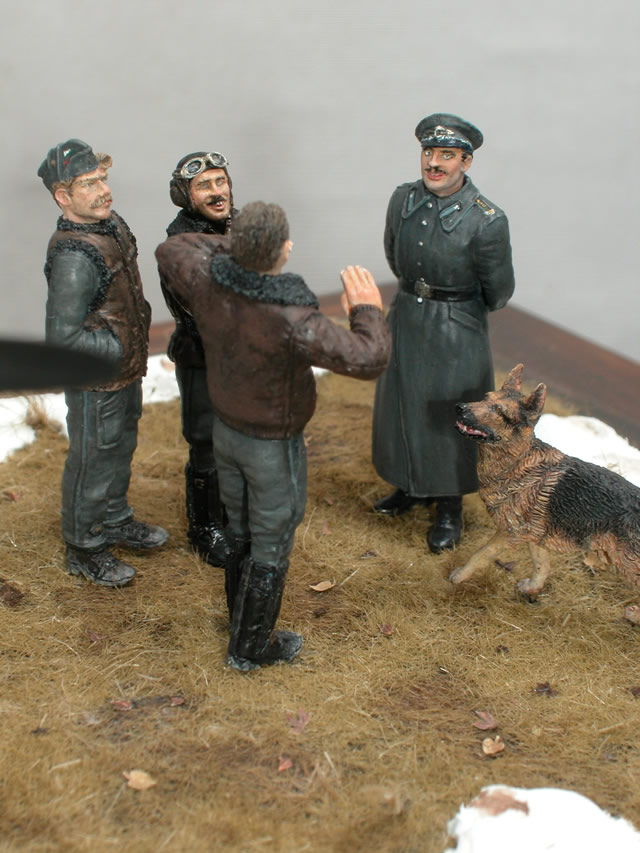
It took me a lot of time and effort to make the male figures - 4 in total and a dog, which was as difficult to make as the men. It was hard for me to catch and convey Spisarevski's face expression - his specific impish smile and noble face. Another great person that I reproduced is of the ace from WW II Stoyan Stoyanov. It is not by chance that he was the pilot who had the most numerous successful flights - 15 air victories.
Here is what Poruchik Stoyan Stoyanov said - a fighter pilot, bearer of three military crosses, about his great friend Spaich: 'There are famous people who are disparate from the others - once you meet them it will last forever. Spisarevski was one of them. He had a manful, stout and well-built figure, a peculiar step and a typical accent, and he was always considerate to the others. He was also very different from his colleagues. Generally he was an easy-tempered with slow precise gestures and good manners. He cared for people and was generous, broadminded, a man of good company and fun. All the soldiers loved and respected him because of his naturalness and loquacity. However, if he was angry about something he was awful. He did not act for himself but always in defence of the others, of the weaker ones. He thought highly of his friends in particular. He would go to great lengths for his friends but he answered back when they hurt his feelings as a Bulgarian. The other thematic figure which made a lot of work for me, I hope you can make it out amongst flying officer George Kyumyurdjiev's documentary photos. My decision was to include this hero in the composition was not by chance again. He was one of Spaicha's closest friends and here is what Stoyan Stoyanov wrote: 'It was the fourth attack of Sofia. The previous day was St.Nicholas' Day and we were all at flying officer Poruchik Nikolay Yordanov's place. Time was flying very fast and nicely, better than being on duty….. Of course, it was nicer - the fire was blazing in the stove, there was a muscatel wine from Karlovo-home made, it just made the blood tingle and life clear and desired. Small flyer's delights. These men's lives hung by a thread all the time. And when they had any chance, they eased off 'At ease-set right!,i.e. pass over the other world where there were no troubles and 'flying fortresses'.
Flying officer Poruchik Spisarevski and second flying officer Podporuchik George Kyumyurdjiev are sitting on a big field box at the far end of the room by the wall. Spisarevski is holding with his left hand Kyumyurdjiev - The Birdy they called him, upon his shoulders. Flying officer Poruchik Stoyanov was very strict to himself. Whether he would fly on the following day or not, feel sleepy or not, when the clock stroke 10 - you could find him in his bed. The same is happening now. He is leaving. Spisarevski tapped his friend - the Birdy on his shoulder and said with a smile: 'Now, tell me Birdy, we are going to stay, aren't we, it's not a big deal that Poruchik Stoyanov is leaving us?
That's the way how Stoyanov would remember both of them - held in their arms.
George Kyumyurdjiev. He was only 24 years old. He had well-built athletic physique and was very shy.
Dimitar Spisarevski. Passionate, honest brave Bulgarian patriot, soaked by strong hatred to the air terrorists.
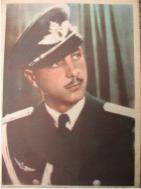
I'd like to add some historical facts about flying officer George Raychev Kyumyurdjiev. He joined in three aerial battles, carried out 4 fighting tasks and had two air victories. He was posthumously awarded the Order of a Military Cross. His mortal remains were put in his native town -Stara Zagora, a monument was also erected and even a street named after him. Alas - not more than a year later the coming illegal occupation anti-Bulgarian and Soviet-Partisan power would erase his grave, knock down his monument and renamed the same street and his feat. He was considered as the was one to blame that he gave his life for the Bulgarian kingdom!?!
There are differences of opinion about the dog on the diorama! I read an article in a pensioners newspaper which is amongst other articles on the same subject - pilots veterans from WW II, and Mr Dimitar M. Ivanov said in the 'Third Age' newspaper that he knew Spisarevski from Bozhurishte airfield and described his dog as the Alsatian - 'Hector'!
I modelled the dog once again and made it of the scale of 1:32, and I used, as a basis, the Alsatian from the animal set of Tamiya 26018-1/35 LIVESTOCK 1:35, but the head of the dog is my own copy and to the development of the lying Alsatian to Tamiya 35212 German Soldiers at Field Briefing! But the changes I made were so great that only the posture was left from the dog from Tamiya. The paints which I used for the Alsatian were Revell Matt 37, 15, 35 for the darker back of the dog and Agama-20, RLM04+Humbrol-34+White for the light legs, chest, neck and stomach. I finished my work with matt varnish as I imitated the wet muzzle and the eyes with gloss varnish. I have to specify here that I use only enamel paints. Despite the RLM precision of Agama, I was disappointed with the fact that after opening the box the paint consistency changed very quickly and a hard skin appeared on the top. I used Revell and Humbrol flesh colour for the faces and hands, I added a little bit Pink for more vivid look. I applied in the eyes' cleft thinly very light blue in order to make the sight and human expression deeper. Only Kyumyurdjiev's eyes were with white eye sockets and pupils as it was on the picture. He had more Mediterranean look and respectively I made his complexion darker. I hope you like it!
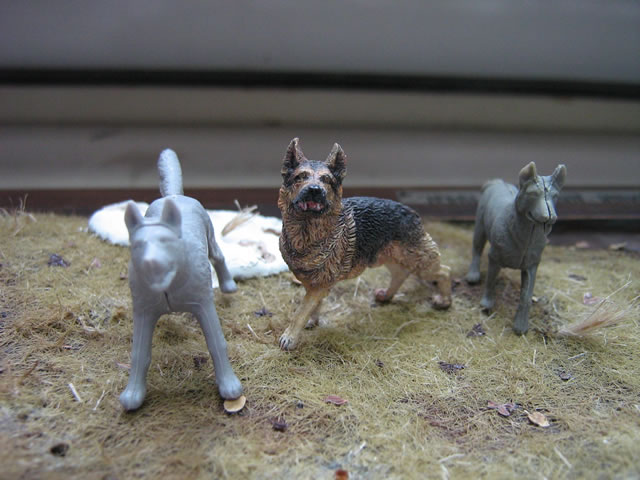
Because of the peculiarities of Bulgarian uniforms and insignia, as you can see, I had to fall back on the services of the advertising agency which made the needed specific Photoetched parts for me, like belt buckles with a lion device on it, a small lion for the mechanic's hat, epaulettes, zip-fasteners, pilots' boot buckles. The dark brown colour of the pilots' jackets I created myself and I cannot recall but only Stoyan Stoyanov's jacket was sprayed with gloss varnish. As you can see on the black and white picture, the ace Stoyan Stoyanov is with a glossy reflection of his jacket and he deserves it because he was not only the most successful pilot fighter at that time but he also was the commander of the wing fighters Messerschmitt Bf 109 from the sixth fighter regiment.
A hero in the war Stoyanov was employed in the Military Air Forces of the People's Republic of Bulgaria but he was treated with distrust by the new system of government and later on he was completely ignored by them. However, this is a common attitude to a tsarist officer and the bearer of the German Iron Cross. He was dismissed from the Military Air Forces in 1956 when the Hungarian national uprising against communism alarmed all the administrations in Eastern Europe which were tributary to Moskow. Deprived of his service pension Stoyan lived in poverty more than 30 years, as a monk and worked as a gardener in Rila monastery. Thanks to his German language skills, he worked also as a guide in Rila monastery museum. In the monastery Stoyanov met famous foreign veterans from the war who had come as tourists or visitors of the monastery. They were surprised very much from the miserable fate of the hero from the war.
But let us return to the colouring of the figures. The most difficult thing for me was to bring off the mouse-grey colour of the uniforms, specific for the Military Air Forces of His Majesty! The colour on the photos is not always exact, it depends on the light! My friend - the historian Ventsislav Chakov, became enthusiastic about the Bulgarian and world Historical Aviation, was my main adviser and he often made some remarks about the colours I used. The mouse-grey colour plus a little bit violet and green I managed to get through some layer application, simulating the rough structure of woolen stuff from which winter uniforms were being made. The colours are as follows: Revell-79, Agama RLM-75,74 plus a little bit violet! The boots are black, as I applied with Matt varnish only the main and the most inner part of the boots. The aeromechanic is the only person which is not a real image but the face can be familiar to some of you and you will be right because I remodelled this up to the development of the driver's head - 1:35 scale from 'ZVEZDA' 3529 ZIS-5B kit.
Despite my desire to put an accent on Spisarevski's figure, the plane set itself in the proper place as the most prominent unit in this diorama. You can understand that Messerschmitt Bf 109 G-2, which you can see, is my own conversion based on the model made by Hasegawa Me 106 G-4/trop 1:32. I had the opportunity to buy the re-packed 'Revell' version and on the very face of the plastic parts I noticed that it leaves much to be desired. I got a good drawing of desired version G-2 and I understood very soon that it did not meet the case with the only change of resin kit of the Czech company Aires Bf 109 F wheels, but it was necessary to compare very thoroughly the differences in the drawings and to see what could be worked out on the kit. In fact some of the necessary parts for the G-2 version were available in the kit but they were deleted by the instructor for fitting together as necessary! To touch on the fitting instructions of Revell, I would say that in some cases it was not only rather tricky and confusing but also the instructions were wrong. The next extra part which I got was one of DMCMe 109G/K Corrected Spinner company. With this the Messer really looked more vigorous and stream-lined, typical for this ruthless aerial battle fighter. Regarding the quality of this Spinner, the company which had made it could have been more meticulous in its production. I did not like the way it fitted to the engine segment and I decided to adjust it to the original medial disc from the plastic model. I moulded some copies of this segment because I had some fears and first two mouldings were not successful. It was not until the third try that I was pleased with it. Unfortunately, there were no unstitched rivets in this big model. It isn't required but in this professional scale it is advisable.
Comparing the drawings big differences could be seen in the positioning of the frames of the machine-gun sockets in the upper part of the engine segment hoods. I had to make an order for the make of Photoetched jobs so that the plane would look more authentic. I had to work hard on hold-back parts of the extra tank. This concerns not only the parts of the tank itself but the device which is between the wings of the plane. I know that this Messerschmitt caused me some troubles but I also have to admit that it was the first time I made a stand model for a plane.
For the colouring and laying of camouflage on the plane I used Agama paints and RLM system for designation, as follows: yellow nose, yellow control tail and the marginal ends of the wings with RLM-04. The back of the Messer in darker grey-blue nuances RLM-74, right after it the lighter RLM-75 and at an angle it goes over again RLM-74 to the tail. A little under the level of the canopy and the whole lower part with RLM-76. For the upper part of the wings and stabilizers I used the darker grey-blue RLM-74 and RLM-75. As you can see I decided to stick to the German standards and it is not by chance. At that time we became allied with Wehrmacht and people who served at Bulgarian airfields and maintained the new and expensive equipment bought from Germany, aimed at copying the requirements of Luftwaffe. The enclosed photos support the fact unmistakably that there were Bulgarian Messerschmitts which had sharp yellow painted noses, and to be more precise, the hoods of the engine segment to the end of the oil-heated radiator. The designated symbols typical for Bulgarian aviation and armour-equipment are black X-es on a white square with black frame, or as they are otherwise known' Andreevski' crosses (Andrew's crosses). For the aforementioned crosses I used masks from foil and it wasn't that easy to gain a satisfactory result. I had the patterns cut professionally in an advertising agency. At the last moment I decided to make the front windows (windscreen) pulled in open-rear position in order to look more different than the common G-2s in the same scale.
The decals which I used for the notice of the wings in Bulgarian 'Attention', 'Don't step here!' and 'You can only step here!', I could not make through patterns. The decal paper was the only way of making it and so I did it. I bought the only decal paper I managed to find 'ACT' Expert-Choice Decal film but unfortunately it turned out to have quite a thick carrier. There is one more notice in Bulgarian which I know of - 'Lift here'. The two-lined notice is by the tail, above the hole for maintenance. The diorama is made of wooden frame with a wooden bottom, filled with thin layer MODELIGR MATERIAL-PASTA plastic brown clay made in Italy.
I deliberately painted the ground dark to black brown where there would be dry December grass, just in order to be able to make it lighter with thin acrylic light brown paint on the already attached grass. I also bought laser cut leaves of 'plus model'. I definitely preferred faded autumn leaves 1:35 scale and I painted them in addition after attaching them to the ground. The grass is 'Woodland Scenics' but I mixed it with longer and thicker fine cut sprays of dry flax fibres (which you can still find in the water supply shops) and they are used as a packing between thread-bare metal joints. The same fibres I used to imitate the dry weed sprays. It has a good effect when taking pictures outdoors, the daylight gives a slight greenish shade of artificial grass.
I do not go into details primarily about different painting techniques, authentic appearance and scaling the paints, as well as details about exterior and interior of the fighter and the diorama itself. Everything is of secondary importance compared to Spisarevski's figure, which was my main idea, and the rest of it is a background. In order not to look too static, I decided to enrich the diorama with some extra accessories typical for the airfields at that time. I did not want to overcrowd the scenery but at the same time, it is already overshadowed by the Messerschmitt. I wanted to present the figure group as a dominating subject in the restoration of a friendly talk between Bulgarian pilots before a battle flight action. Two boxes full of cartridge and gun belts are ready to be loaded for the next battle flight. A bicycle Tamiya with photoetched segments of the Polish ABER company, leaned by the old, faded and shabby box full of food, wrapped in newspapers, and half a bottle of red wine - home made, on the top. Spaicha's hat was on the box with gun shells, on the Bulgarian edition of the German 'Signal' magazine, an issue of the summer 1943. I made the supporting struts of the plane wheels because it can be clearly seen on many photos that they are widely used. Three ravens in the background as a symbol of an impending menace.
It is cold and often snowy in December but Spisarevski's heroic deed was accomplished in the same month. Because the diorama is a restoration of the Spaicha's last days at the Bozhurishte airfield I decided to emphasize the winter December scenery by the imitation of melting snowy drifts. I made it with a simple plaster to give the real look of this winter scenery. But the final fine granular structure I got by piling snow that is used for modeling railways on the already hard-set plaster mouldings. I decided not to give a bluish shade on the snow to avoid wet and melting look. This diorama should show that particular December freezing cold when the flights were possible but it did not frighten Bulgarian pilots, that was my wish, and most of all Spisarevski ignoring the freezing wind, with flushed face, explaining with bare hands how he would attack the enemy. That freezing December wind which tilted over dry grass and bushes ruthlessly and was blowing heavily as if symbolically facing the brave pilot and his fight aircraft Messerschmitt 109 G-2 - and he was ready to fly to his heroic immortality.

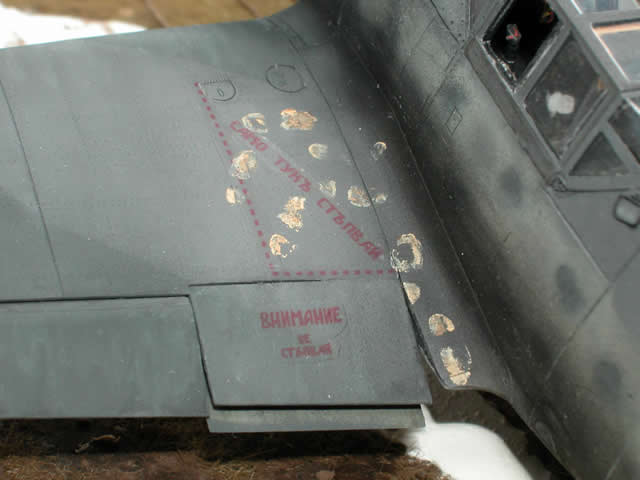




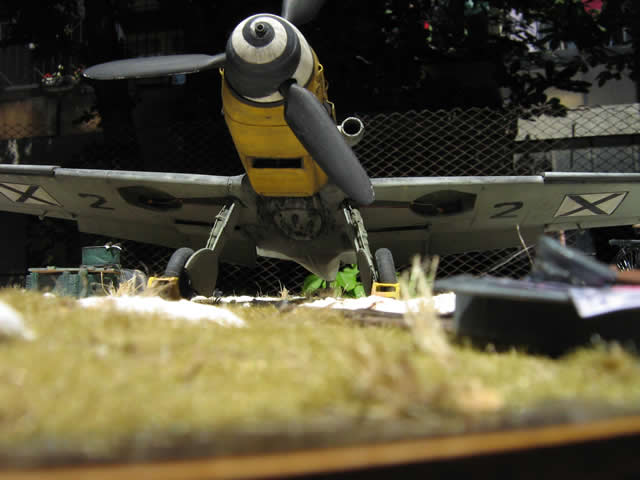


I covered this diorama with a bell-glass edged with wooden frames varnished beforehand in a suitable dark colour. The middle-aged man on the last picture is the reservist group captain Ivan Serdarov who knew Spisarevski in person! In 1943 Mr Serdarov served in the army at Bozhurishte airfield and he flew on Dornier Do 17 as a navigator of 73rd wing for far reconnaissance. The other humble person, all smiles, wearing a red shirt - it is me - Yordan Kolchev from the town of Dobrich, Bulgaria.
As you can see I decided to take the opportunity to invite this veteran-pilot to take a picture as a keepsake of Spisarevski's Messer model. That's the way I see him - as a creative modeller and as a man who is more or less interested in flying officer Dimitar Spisarevski's act of heroism.
Thank you for your attention!
Reference: Remsists-Members of the Young Communist League - this was an organization of young communists and anti-fascists who came to power after 9th September 1944. On the top of the Soviet bayonets, they had the power over the country and killed thousands of innocent Bulgarian people without charge or trial
The Treaty of Neuilly-sur-Seine, dealing with Bulgaria for its role as one of the Central Powers in World War I, was signed on November 27, 1919 at Neuilly-sur-Seine, France.
The treaty established borders over contested territory between Bulgaria, Turkey, Greece and the Kingdom of Serbs, Croats and Slovenes. As a Central Powers belligerent, Bulgaria received the least land, and was required to reduce its army to 20,000 men, pay reparations exceeding $400 million, and recognize the existence of the Kingdom of Serbs, Croats and Slovenes. Bulgaria was required to cede western Thrace to Greece and parts of Dobruja to Romania.In Bulgaria, the results of the treaty are popularly known as the Second National Catastrophe. During World War II Bulgaria, together with Nazi Germany, temporarily reoccupied the territories it had ceded.
BIBLIOGRAPHY collection
- AEROSVIAT 'AEROWORLD' 'IKAR-PRESS' - Ivan Delchev
- AIRGROUP 2000 RETRO SALOON
- AIRGROUP 2000 Captain Dimitar Spisarevski - 'One-man Torpedo, Life and Death
- 'Eagles of Bulgaria', part II Fiery Sky.- Misho Grigorov
- MERIDIANPRESS 'MEN TORPEDOS' - Tsvetan Tsvetkov
- <
> Publishing Sofia, Bulgarian Fighters Part II-Dimitar Nedialkov - AIRGROUP 2000, Air-Raid Aces of the Bulgarian Sky - Luben Ovcharov
- Bulgarian-English Translation by Albena Ivanova
- Edited by Melanie Jane Nixon
ACKNOWLEDGEMENTS
Vencislav Chakov from Balchik and Todor Dragiev from Shumen.
© Yordan Kolchev, 30th November 2008
This article was published on Wednesday, July 20 2011; Last modified on Saturday, May 14 2016
